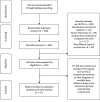Is Acupuncture Another Good Choice for Physicians in the Treatment of Chronic Prostatitis/Chronic Pelvic Pain Syndrome? Review of the Latest Literature
- PMID: 32256909
- PMCID: PMC7085851
- DOI: 10.1155/2020/5921038
Is Acupuncture Another Good Choice for Physicians in the Treatment of Chronic Prostatitis/Chronic Pelvic Pain Syndrome? Review of the Latest Literature
Abstract
This study aimed to evaluate the efficacy and safety of acupuncture for chronic prostatitis/chronic pelvic pain syndrome (CP/CPPS). A search of PUBMED, EMBASE, Central Register of Controlled Trials (CENTRAL), Web of Science, Chinese Biomedicine Literature (CBM), China National Knowledge Infrastructure (CNKI), Wang-Fang Database, Chinese Scientific Journal Database (VIP), and other available resources was made for studies (up to February 2019). Searches were limited to studies published in English and Chinese. Only randomized controlled trials (RCTs) related to the efficacy and/or safety of acupuncture for CP/CPPS were included. Two investigators independently evaluated the quality of the studies. A total of 11 studies were included, involving 748 participants. The results revealed that compared with sham acupuncture (MD: -6.53 [95% CI: -8.08 to -4.97]) and medication (MD: -4.72 [95% CI: -7.87 to -1.56]), acupuncture could lower total NIH-CPSI score more effectively. However, there are no significant differences between acupuncture and sham acupuncture in terms of IPSS score. In terms of NIH-CPSI voiding domain subscore, no significant differences were found between acupuncture and medication. Compared with sham acupuncture (OR: 0.12 [95% CI: 0.04 to 0.40) and medication (OR: 3.71 [95% CI: 1.83 to 7.55]), the results showed favorable effects of acupuncture in improving the response rate. Acupuncture plus medication is better than the same medication in improving NIH-CPSI total score and NIH-CPSI pain domain subscore. In conclusion, the evidence suggests that acupuncture may be an effective intervention for patients with CP/CPPS. However, due to the heterogeneity of the methods and high risk of bias, we cannot draw definitive conclusions about the entity of the acupuncture's effect on alleviating the symptoms of CP/CPPS. The adverse events of acupuncture are mild and rare.
Copyright © 2020 Junjun Li et al.
Conflict of interest statement
The authors declare that they have no conflicts of interest regarding this work.
Figures

















Similar articles
-
Effect of acupuncture on clinical symptoms and laboratory indicators for chronic prostatitis/chronic pelvic pain syndrome: a systematic review and meta-analysis.Int Urol Nephrol. 2016 Dec;48(12):1977-1991. doi: 10.1007/s11255-016-1403-z. Epub 2016 Sep 2. Int Urol Nephrol. 2016. PMID: 27590134
-
Non-pharmacological interventions for treating chronic prostatitis/chronic pelvic pain syndrome: a Cochrane systematic review.BJU Int. 2019 Aug;124(2):197-208. doi: 10.1111/bju.14492. Epub 2019 Jan 17. BJU Int. 2019. PMID: 30019814
-
The Efficacy and Safety of Extracorporeal Shockwave Therapy versus Acupuncture in the Management of Chronic Prostatitis/Chronic Pelvic Pain Syndrome: Evidence Based on a Network Meta-analysis.Am J Mens Health. 2021 Nov-Dec;15(6):15579883211057998. doi: 10.1177/15579883211057998. Am J Mens Health. 2021. PMID: 34911370 Free PMC article.
-
The efficacy of acupuncture in managing patients with chronic prostatitis/chronic pelvic pain syndrome: A systemic review and meta-analysis.Neurourol Urodyn. 2017 Feb;36(2):474-481. doi: 10.1002/nau.22958. Epub 2016 Jan 6. Neurourol Urodyn. 2017. PMID: 26741647
-
Efficacy of acupuncture for chronic prostatitis/chronic pelvic pain syndromes: study protocol for a randomized, sham acupuncture-controlled trial.BMC Complement Altern Med. 2016 Nov 7;16(1):440. doi: 10.1186/s12906-016-1428-y. BMC Complement Altern Med. 2016. PMID: 27821109 Free PMC article. Clinical Trial.
Cited by
-
Expression Profiling of L5-S2 Spinal Cord Dorsal Horn in a Rat Model of Chronic Pelvic Pain Syndrome Uncovers Potential Mechanism of Electroacupuncture Mediated Inflammation and Pain Responses.J Pain Res. 2022 Jul 26;15:2067-2084. doi: 10.2147/JPR.S364972. eCollection 2022. J Pain Res. 2022. PMID: 35923840 Free PMC article.
-
The Role of Acupuncture and Its Related Mechanism in Treating Chronic Prostatitis/Chronic Pelvic Pain Syndrome.Int J Gen Med. 2023 Sep 6;16:4039-4050. doi: 10.2147/IJGM.S417066. eCollection 2023. Int J Gen Med. 2023. PMID: 37700742 Free PMC article. Review.
-
Acupuncture for Chronic Prostatitis or Chronic Pelvic Pain Syndrome: An Updated Systematic Review and Meta-Analysis.Pain Res Manag. 2023 Mar 14;2023:7754876. doi: 10.1155/2023/7754876. eCollection 2023. Pain Res Manag. 2023. PMID: 36960418 Free PMC article.
-
Effects of Electroacupuncture with Different Waveforms on Chronic Prostatitis/Chronic Pelvic Pain Syndromes: A Randomized Controlled Trial.Contrast Media Mol Imaging. 2022 Jul 13;2022:6866000. doi: 10.1155/2022/6866000. eCollection 2022. Contrast Media Mol Imaging. 2022. Retraction in: Contrast Media Mol Imaging. 2023 Jul 19;2023:9838623. doi: 10.1155/2023/9838623. PMID: 35935300 Free PMC article. Retracted. Clinical Trial.
-
Efficacy of Dry Needling and Acupuncture in the Treatment of Neck Pain.Anesth Pain Med. 2021 Apr 3;11(2):e113627. doi: 10.5812/aapm.113627. eCollection 2021 Apr. Anesth Pain Med. 2021. PMID: 34336626 Free PMC article. Review.
References
Publication types
MeSH terms
LinkOut - more resources
Full Text Sources
Medical
Miscellaneous

